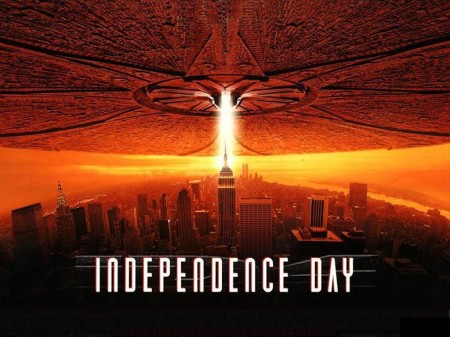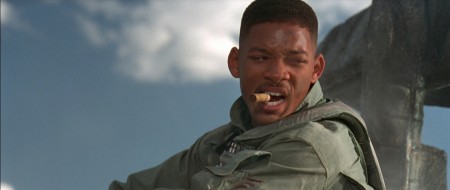Strange Moments in Solid Movies: Boomer the Dog FTW in Independence Day
With an insatiable desire to depict worlds in disarray, Roland Emmerich has spent the better part of three decades pumping out grandiose blockbusters bedecked in social destruction with a flair for the skeptical. That isn’t to say there is a whole lot of method behind the madness; Emmerich’s love for blowing stuff up–be it a sturdy building or established fact–is just too primary, too outrageous. And he’s willing to draw on dicey pasts (The Patriot, Anonymous) and controversial presents (The Day After Tomorrow, 2012) to lay waste to the good earth of cinema, scorching anything that resembles sensible storytelling or true scientific inquiry in his movies’ cataclysmic march to commercial success. And leader of this bombastic parade is Independence Day, Emmerich’s most entertaining film to date.
ID4 is the director’s most inspired spectacle of the ludicrous, displaying his patented lunacy with an unabashed gusto. Following a group of sundry characters–a resolute pilot (Will Smith), his stripper girlfriend (Vivica A. Fox), an eccentric scientist (Is there any other kind? Or, more to the point, is there any other Jeff Goldblum?), a continuously drunk dust cropper (Randy Quaid), and a schwartz swagged-out President (Bill Pullman), to name just a few–the narrative is a ridiculous slice of life until it is hacked to pieces by hoarding extraterrestrial. Essentially existing within the basic trappings of an alien invasion story where humankind has to fight back, ID4 is the definition of “blown out of proportion” with a decidedly glammed-up look (thanks to great special effects) and glossed-over inhumanity (thanks to how the special effects are employed: to make the demises of countless people look about as cool as Will Smith).
Now, this sense of inhumanity is a snag that is inherent in all disaster movies because, as the saying goes, “the death of one man is a tragedy; the death of millions is a statistic.” The specific tends to be that much more powerful because you can wrap your head around one life much easier, which allows you to better understand what is lost and gained in a person’s heartbreaking end. And witnessing this one-versus-millions concept play out on the big screen is both fascinating and strange as it rouses an excited detachment. Since the audience gets to know these characters (the specific “ones” in the aphorism), we want them to overcome any obstacle they face because they are not faceless (i.e. like everyone else–the “millions”). However, there is one strange moment in ID4 that takes this dynamic to its most preposterous limit: the remarkably timed leap of Boomer the dog. Take a look:
During the alien onslaught, Jasmine Bubrow (Fox) and her son manage to survive by taking shelter from an all-consuming blast in a doorway in a tunnel (which is unquestionably a far-fetched opening in its own right) as other people try but fail to outrun the fire. Obviously, juxtaposing the known characters with the random runners enhances the lethality of the situation and it duly showcases how impressive the known characters’ survival is; they succeed when so many others are swept away. But this development, as previously outlined, is commonplace in such movies; the audience wants these characters to survive and will root for their salvation even as many others meet their dooms. It’s an unfortunate corollary of the genre, but so be it; it’s how it works because everyone cannot be presented as main characters, with backstories and motivations. However, when contextualized in this horrific predicament, Boomer’s getaway and last-second jump is all the more absurd. Emmerich, taking this notion of specificity to hilarious lows, gives the known dog a dramatic beat that most significant characters who survive the events of the movie don’t even get, let alone characters who don’t survive (like the First Lady and the once-airborne Harry Connick Jr.). In giving Boomer his moment in the spotlight, Emmerich suggests that the dog is more important than those left in the dark.
Certainly, there is a pervasive cliche at work here, where dogs (and other pets, for that matter) aren’t often killed off or, when they are, their deaths are given dramatic weight typically allotted to human characters, but this variation really calls into question its legitimacy. Dogs may be man’s best friend, but it’s puzzling how the human part of this expression is oftentimes more susceptible to pain and death in stories that focus on them far more than on the dogs. This susceptibility may have something to do with human agency in the narrative, but it seems to have much more to do with the pleasing the audience than narrative necessity. If dogs are man’s best friend, then upholding this fact in the movies is the best way to make the canine-loving audience happy. After all, ID4 (and other movies that perpetuate this convention) is commercial fare at its core.
But still, even though Boomer’s escape may be a feel-good moment for some, to me it amounts to a strange dismissal of human significance because of the many people who have no capacity for such good feelings in the movie itself; they’ve been burnt to a crisp, making them truly faceless indeed.





